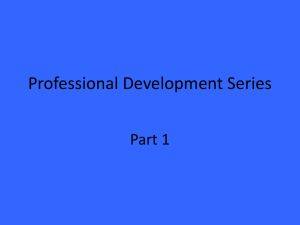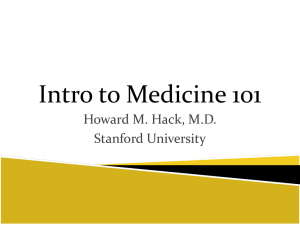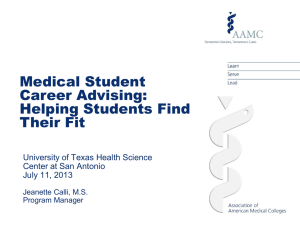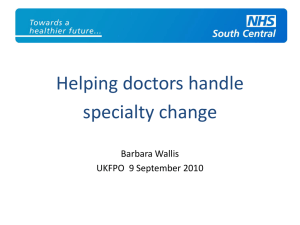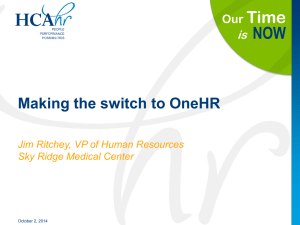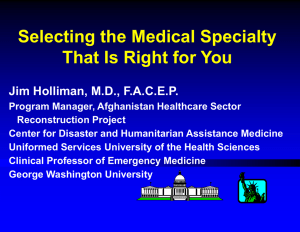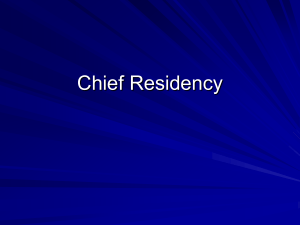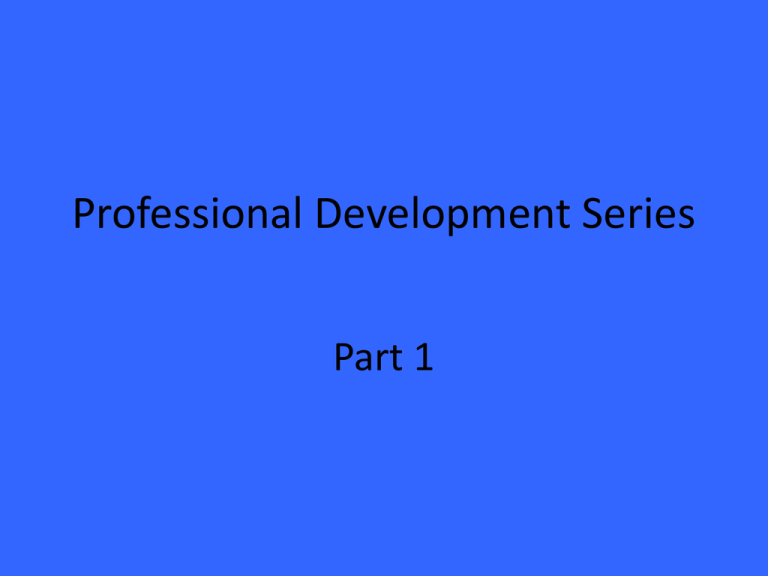
Professional Development Series
Part 1
What will I be when I grow up?
The answer is no longer just “doctor”
The Big Decision
• Most med students spend more time deciding
what car to buy than on selecting a career.
• Little thought goes into a lifelong decision.
• Hasty decisions can lead to burnout, changing
residency programs, an unhappy career.
Statistics/Job Satisfaction
• 40% of physicians report being very satisfied
• 20% of physicians report complete
dissatisfaction
• The rest are somewhere in between
Pitfalls to Choosing a Specialty:
• Anxiety over exams/grades detracts from focusing on
the merits of the specialty
• Subjective grades can influence final impressions
• Bitter residents and attendings/personality conflicts
• One bad rotation does not preclude one from choosing
that specialty
• Lack of participation
• Lack of “nitty gritty”outpatient experience
• Not enough time to look at every specialty in 1 year
• Lack of guidance resources/lack of time
Over 60 Specialties and Subspecialties
•
•
•
•
•
•
•
•
•
•
•
•
•
•
•
Allergy and Immunology
Cardiology
Dermatology
Family Practice
Genetics
Internal Medicine
Neurosurgery
OBGYN
Ophthalmology
Otolaryngology
Pathology
Physical Med/Rehab
Preventive Med
Radiology
Thoracic/CV Sx
Anesthesiology
Colon and Rectal Sx
Emergency Med
General Sx
Infectious Disease
Neurology
Nuclear Medicine
Oncology
Orthopedic Surgery
Pain Management
Pediatrics
Plastic Sx
Psychiatry
Rheumatology
Urology
Sample Specialty Divisions
Hospital Based Specialties:
Radiology, Pathology, Emergency, Surgery
Comprehensive care for one population:
Pediatrics, OBGYN
Primary Care:
Family Practice, Internal Medicine, Pediatrics
Tertiary Care/Referral-Based/One Organ System:
GI, Dermatology, Urology, Neurology, Cardiology
Myths and folklore or truth??
• All orthopods are jocks.
• Gynecologists have the worst sex lives of all
doctors
• Pathologists are socially inept.
• You should be a surgeon like your father.
• Psychiatrists are crazy!
• Dermatology is good money and short hours.
• General surgeons do all the work with little pay.
• ER docs are adrenaline addicts.
• Internists are nerds.
Four Domains of Career Assessment
• Personal Values – what is important to you
– Physician Values in Practice Scale
• Interests – what you like
– Medical Specialty Preference Inventory
• Personality – what are you like?
– Myers-Briggs Type Indicator
• Skills – what you can do and do well
– Experience on clinical rotations
Personal Values:
•
•
•
•
•
•
•
•
Hours
Income
Intellectual Stimulation
Type of Patient Population
Generalist vs Specialist
Work Environment
Patient Contact
Social Status
Other considerations:
•
•
•
•
•
Paperwork/Managed Care
Job Opportunities
Length of Training
Academic Competitiveness
Malpractice/Litigation
What are your interests?
Anatomy
Surgery, Radiology
Histology
Pathology, Derm
Biochemistry
Internal Medicine
Neuroscience
Neuro, Neurosx, Psych, Rehab
Immunology
Path, Infectious Disease
Physiology
Surgery, IM, Anesthesiology
Behavioral Science
Psychiatry
Genetics
Peds
Molecular Biology
Pathology
Microbiology
Infectious Disease
Pathology
IM, FP, Pathology
Pharmacology
Anesthesiology, IM
Personality: What are you like?
Results of multiple studies:
Surgeons: extroverted, practical, social, less creative,
competitive, structured
Controllable lifestyle specialists: withdrawn and rebellious
Hospital-based specialties: low tolerance for ambiguity,
desire high structure
OBGYN: warm and helpful
Primary care: desired long term patient relationships
Action oriented people who desire immediate
gratification: sought out ER, surgery, anesthesiology
Myer-Briggs Personality Type Indicator
MBPTI
• Developed in the 1950’s
• Used in medical schools across the country
• Helps guide specialty selection by determining
personality and temperament
• Identify strengths and weaknesses
• Take each year for best results
• www.capt.org for a fee can get expert
feedback
MBTI: Four dimensions of personality
yield 16 different personality types
– Extroversion (E) vs Introversion (I): How we interact
with the world and where we direct our energy
– Sensing (S) vs Intuition (I): The kind of information we
naturally notice
– Thinking (T) vs Feeling (F): How we make decisions
– Judgment (J) vs Perception (P): Whether we prefer to
live in a more structured way or a more spontaneous
way
Extraversion
E
Introversion
Interest Orientation
Outer world of
actions,
objects, and
people
Inner world of
ideas and
concepts
I
Sensing
S
Intuition
Perception
Immediate
reality and
direct
experience
Inferred
meanings and
relationships
N
Thinking
T
Feeling
Judgment
Reliability of
logical order –
cause and
effect
Priorities
based on
personal
importance
and values
F
Judgment
J
Perception
Environment Orientation
Judging
attitude –
Control of
events and
systematic
planning
Spontaneity –
Curious,
awaiting
events and
adapting to
them
P
ISTJ
ISFJ
INFJ
INTJ
“Take Your
Time and Do It
Right”
“On My Honor,
to Do My
Duty…”
“Catalyst for
Positive
Change”
“Competence +
Independence =
Perfection”
ISTP
ISFP
INFP
INTP
“Doing the Best
I Can With
What I’ve Got”
“It’s the
Thought That
Counts”
“Still Waters
Run Deep”
“Ingenious
Problem
Solvers”
ENFP
ENTP
“Anything’s
Possible”
“Life’s
Entrepreneurs”
ENFJ
ENTJ
“The Public
Relations
Specialist”
“Everything’s
Fine – I’m in
Charge”
ESTP
ESFP
“Let’s Get
Busy!”
“Don’t Worry,
Be Happy”
ESTJ
ESFJ
“Taking Care of “What Can I Do
Business”
For You?”
ISTJ
ISFJ
INFJ
INTJ
Derm, OBGYN,
FP, Urology,
Ortho
Anesth,
Ophthal, FP,
Peds
Psych, IM,
Thoracic Sx,
Gen Sx, Path
Psych, Path,
Neuro, IM,
Anesth
ISTP
ISFP
INFP
INTP
Psych, Cardio,
Neuro, Derm,
Path
Neuro, Path,
Psych, Cardo,
Thoracic Sx
ENT, Anesth, Anesth, Uro, FP,
Radio, Ophthal,
Thoracic Sx
FP
ESTP
ESFP
ENFP
ENTP
Ortho, Derm,
FP, Radio, Gen
Sx
Ophthal,
Thoracic Sx,
OBGYN, Ortho,
Gen Sx
Psych, Derm,
ENT, Peds
ENT, Psych,
Radio, Peds,
Path
ESTJ
ESFJ
ENFJ
ENTJ
OBGYN, FP,
Gen Sx, Ortho,
Peds
Peds, Ortho,
ENT, FP, IM
Thoracic Sx,
Derm, Psych,
Ophthal, Radio
Neuro, Cardio,
Uro, Thoracic
Sx, IM
Choosing Your Specialty
• Step 1: Select specialties of interest
• Step 2: Select factors important to you
• Step 3: Rate your specialties
Glaxo Pathway Evaluation Program
http://www.smbs.buffalo.edu/RESIDENT/CareerC
ounseling/interior.htm?self-assessment.htm
Self assessment will rate medical specialties
according to compatability
Co-sponsored by Duke University
Glaxo Critical Factors
•
•
•
•
•
•
•
•
•
•
Caring for Patients
Continuity of Care
Autonomy
Diversity
Personal Time
Expertise
Income Satisfaction
Creativity
Certainty of Outcomes
Clinical Decision Making
• Patient Decision Making
• Interacting with Other
Physicians/ Members of
Health-care Team
• Manual /Mechanical
Activities
• Pressure
• Responsibility
• Schedule
• Security
• Sense of Accomplishment
AAMC Careers in Medicine
Program
Password protected
•
•
•
•
•
Year 1
Orientation to Careers in Medicine
Seek out an advisor or mentor
Understanding Yourself
Complete the Specialty Indecision Scale for
personalized guidance on your career
concerns.
• Attend CiM workshops
• Begin completing self-assessment exercises
Year 2
* Continue self-assessment
* Complete self-assessment exercises
* Review completed Personal Profile with advisor
Exploring Options
* Begin gathering basic information about specialties of interest
through CiM Specialty Pages, other online sites, and library
research
* Attend Specialty Panel and Information Group sessions
provided by your school
* Compare your self-assessment information to the
information you have gathered about specialties. Narrow down
your specialty interests to 3-4 top choices
* Plan your 3rd year schedule
* Take Boards Step 1
• Year 3
• Begin clinical rotations
• Review the Charting Outcomes in the Match
report to assess qualifications and
competitiveness for different specialties
• Conduct informational interviews and/or
participate in preceptorships
• Contact associations and specialty organizations
• Meet with your advisor to discuss your top
choices
• Complete the "Choosing Your Specialty" exercise
• Year 4: Getting into Residency
• Research residency training programs through AMA's
FREIDA , AMA's Graduate Medical Education Directory
(Green Book), or Osteopathic Opportunities
http://opportunities.osteopathic.org/
• Complete the Residency Preference Exercise
• Begin reviewing and comparing residency programs
• Begin preparing residency applications.
• Complete applications and designate programs to
which your materials will be submitted
• Take Boards Step 2
• Interview with residency programs
• Complete the Residency Program Evaluation Guide
Sources for Researching Residency Training
Programs
• CiM specialty pages
http://www.aamc.org/students/cim/start.htm
• AMA’s FREIDA
http://www.ama-assn.org/ama/pub/educationcareers/graduate-medical-education/freidaonline.shtml
• Graduate Medical Education Directory
http://opportunities.osteopathic.org/
What Do I Do Now?
• Excel in your clinical clerkships
– Program directors like to see as many clerkships with Honors as
possible – especially in specialty of choice
• Explore extramural elective opportunities:
– http://www.aamc.org/students/medstudents/electives/start.ht
m
– Shadow drs on breaks and holidays, engage in research projects
– Summer between 1st and 2nd year: National Health Service
Corps, AMSA/SALUD
• Participate in CiM self-assessment and Glaxo Pathway
Program
• Explore specialties through personal experience, talking
to others, CiM, Glaxo, and other resources
Session 2: Surviving 3rd and 4th Year
Clerkships
Session 3: Getting Into Residency
•
•
•
•
Applying for residency
Writing a CV and personal statement
Getting letters of recommendation
Residency interviewing
Choosing a Career in Medicine:
Sources:
1. The Ultimate Guide to Choosing a Medical
Specialty, second edition
by Brian Freeman, MD
2. Ren Stinson / University of Iowa
3. Michael G. Kavan, Ph.D
Associate Dean for Student Affairs
Creighton University School of Medicine

